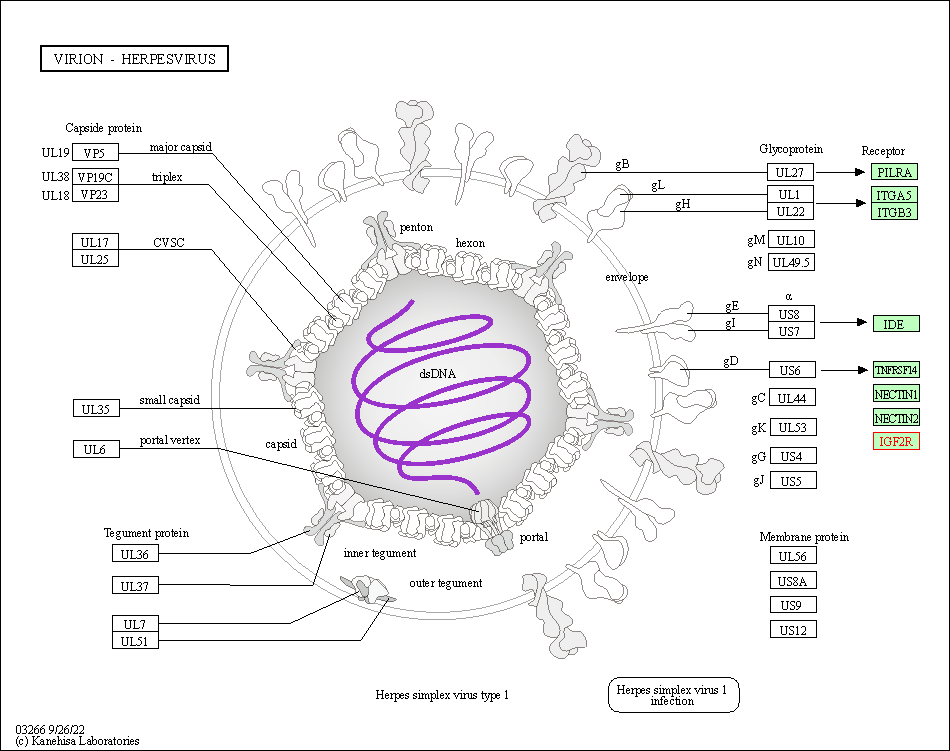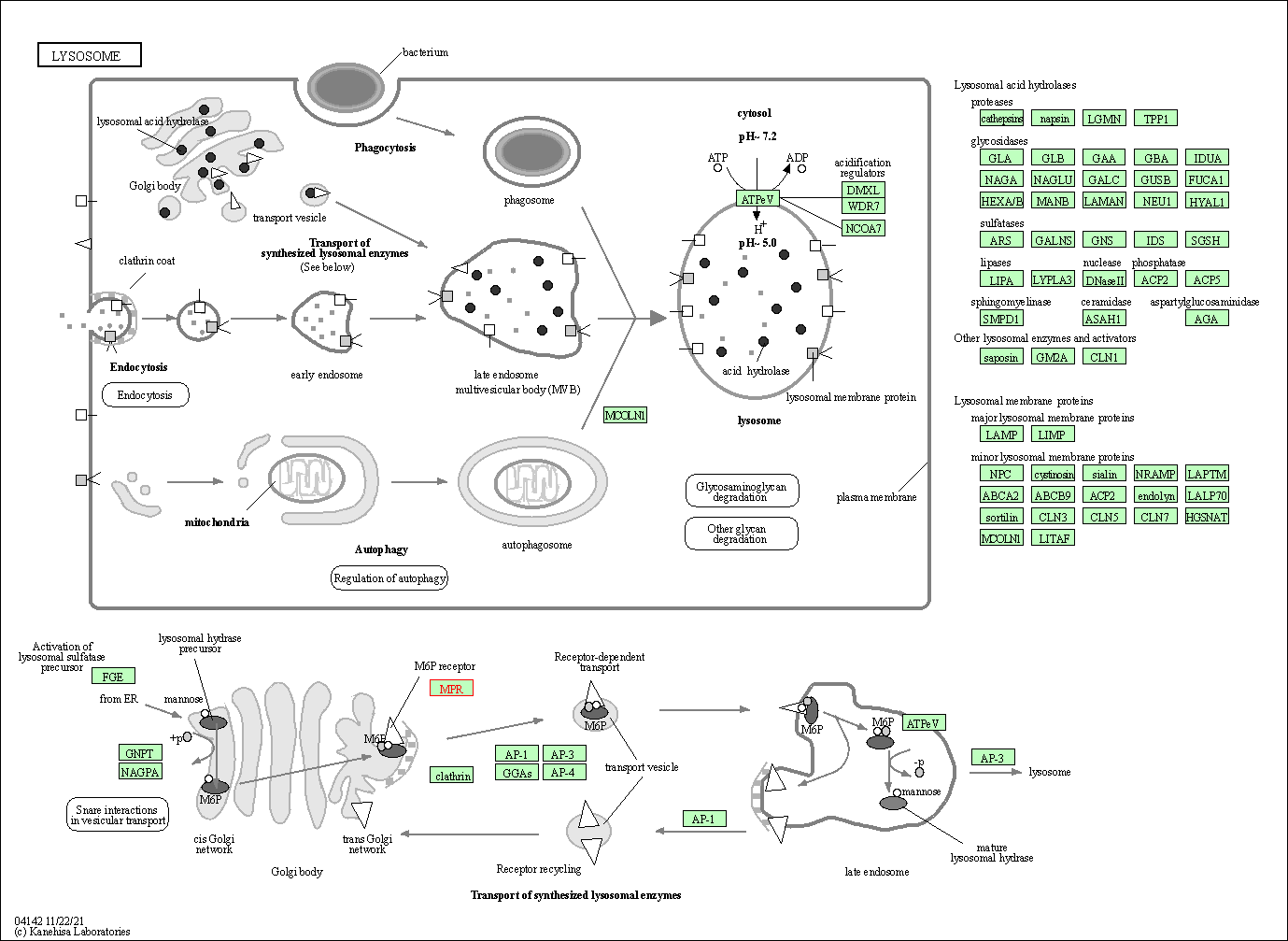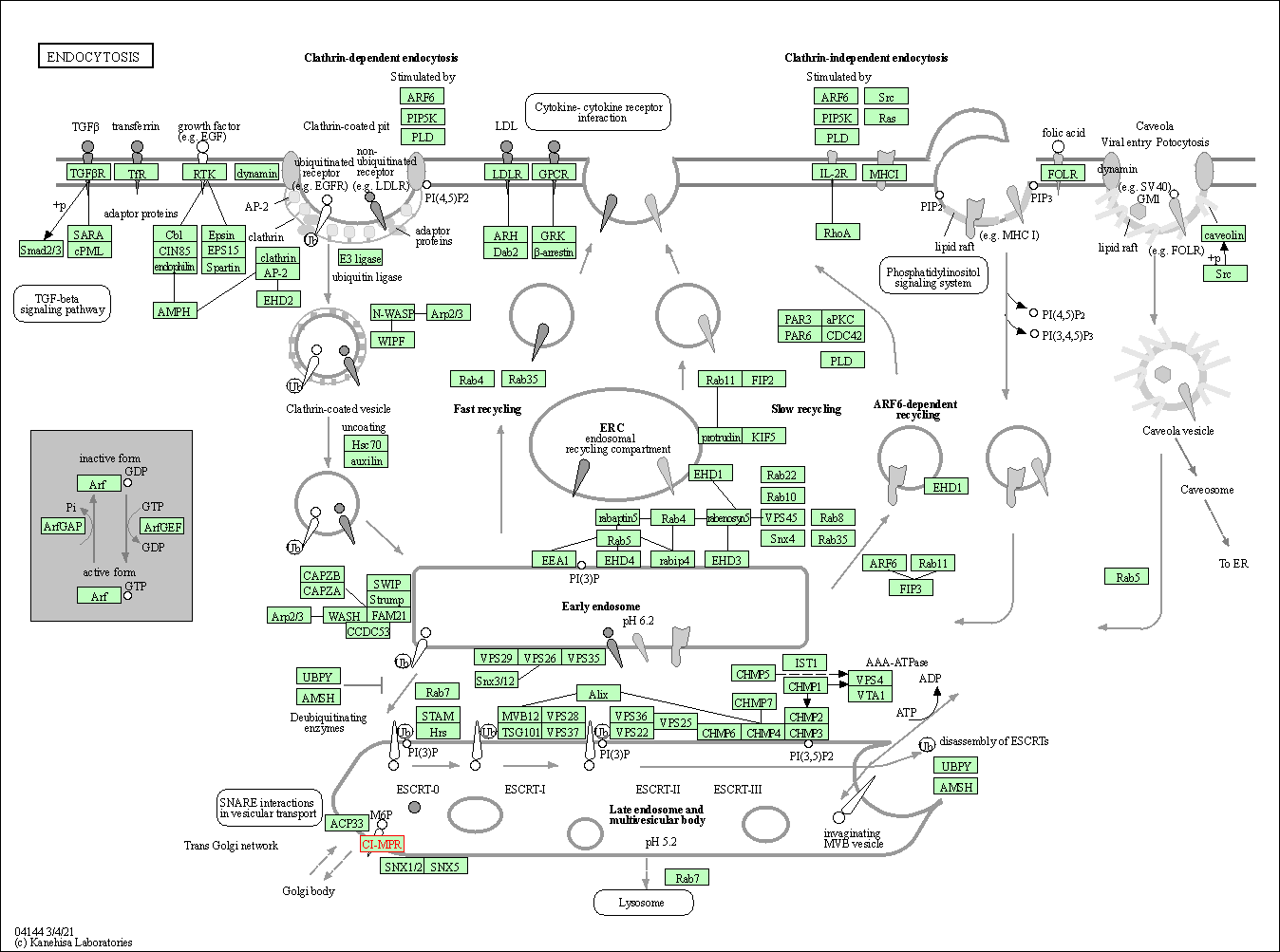Target Information
| Target General Information | Top | |||||
|---|---|---|---|---|---|---|
| Target ID |
T59550
(Former ID: TTDI02126)
|
|||||
| Target Name |
CI Man-6-P receptor (IGF2R)
|
|||||
| Synonyms |
MPRI; MPR 300; M6PR; M6P/IGF2R; M6P/IGF2 receptor; Insulinlike growth factor II receptor; Insulinlike growth factor 2 receptor; Insulin-like growth factor II receptor; Insulin-like growth factor 2 receptor; IGFII receptor; IGF-II receptor; Cationindependent mannose6phosphate receptor; Cation-independent mannose-6-phosphate receptor; CIMPR; CI-MPR; CD222; 300 kDa mannose 6phosphate receptor; 300 kDa mannose 6-phosphate receptor
Click to Show/Hide
|
|||||
| Gene Name |
IGF2R
|
|||||
| Target Type |
Clinical trial target
|
[1] | ||||
| Disease | [+] 2 Target-related Diseases | + | ||||
| 1 | Sarcoidosis [ICD-11: 4B20] | |||||
| 2 | Fibrosis [ICD-11: GA14-GC01] | |||||
| Function |
Lysosomal enzymes bearing phosphomannosyl residues bind specifically to mannose-6-phosphate receptors in the Golgi apparatus and the resulting receptor-ligand complex is transported to an acidic prelyosomal compartment where the low pH mediates the dissociation of the complex. This receptor also binds IGF2. Acts as a positive regulator of T-cell coactivation, by binding DPP4. Transport of phosphorylated lysosomal enzymes from the Golgi complex and the cell surface to lysosomes.
Click to Show/Hide
|
|||||
| BioChemical Class |
Mannose 6-phosphate receptor
|
|||||
| UniProt ID | ||||||
| Sequence |
MGAAAGRSPHLGPAPARRPQRSLLLLQLLLLVAAPGSTQAQAAPFPELCSYTWEAVDTKN
NVLYKINICGSVDIVQCGPSSAVCMHDLKTRTYHSVGDSVLRSATRSLLEFNTTVSCDQQ GTNHRVQSSIAFLCGKTLGTPEFVTATECVHYFEWRTTAACKKDIFKANKEVPCYVFDEE LRKHDLNPLIKLSGAYLVDDSDPDTSLFINVCRDIDTLRDPGSQLRACPPGTAACLVRGH QAFDVGQPRDGLKLVRKDRLVLSYVREEAGKLDFCDGHSPAVTITFVCPSERREGTIPKL TAKSNCRYEIEWITEYACHRDYLESKTCSLSGEQQDVSIDLTPLAQSGGSSYISDGKEYL FYLNVCGETEIQFCNKKQAAVCQVKKSDTSQVKAAGRYHNQTLRYSDGDLTLIYFGGDEC SSGFQRMSVINFECNKTAGNDGKGTPVFTGEVDCTYFFTWDTEYACVKEKEDLLCGATDG KKRYDLSALVRHAEPEQNWEAVDGSQTETEKKHFFINICHRVLQEGKARGCPEDAAVCAV DKNGSKNLGKFISSPMKEKGNIQLSYSDGDDCGHGKKIKTNITLVCKPGDLESAPVLRTS GEGGCFYEFEWHTAAACVLSKTEGENCTVFDSQAGFSFDLSPLTKKNGAYKVETKKYDFY INVCGPVSVSPCQPDSGACQVAKSDEKTWNLGLSNAKLSYYDGMIQLNYRGGTPYNNERH TPRATLITFLCDRDAGVGFPEYQEEDNSTYNFRWYTSYACPEEPLECVVTDPSTLEQYDL SSLAKSEGGLGGNWYAMDNSGEHVTWRKYYINVCRPLNPVPGCNRYASACQMKYEKDQGS FTEVVSISNLGMAKTGPVVEDSGSLLLEYVNGSACTTSDGRQTTYTTRIHLVCSRGRLNS HPIFSLNWECVVSFLWNTEAACPIQTTTDTDQACSIRDPNSGFVFNLNPLNSSQGYNVSG IGKIFMFNVCGTMPVCGTILGKPASGCEAETQTEELKNWKPARPVGIEKSLQLSTEGFIT LTYKGPLSAKGTADAFIVRFVCNDDVYSGPLKFLHQDIDSGQGIRNTYFEFETALACVPS PVDCQVTDLAGNEYDLTGLSTVRKPWTAVDTSVDGRKRTFYLSVCNPLPYIPGCQGSAVG SCLVSEGNSWNLGVVQMSPQAAANGSLSIMYVNGDKCGNQRFSTRITFECAQISGSPAFQ LQDGCEYVFIWRTVEACPVVRVEGDNCEVKDPRHGNLYDLKPLGLNDTIVSAGEYTYYFR VCGKLSSDVCPTSDKSKVVSSCQEKREPQGFHKVAGLLTQKLTYENGLLKMNFTGGDTCH KVYQRSTAIFFYCDRGTQRPVFLKETSDCSYLFEWRTQYACPPFDLTECSFKDGAGNSFD LSSLSRYSDNWEAITGTGDPEHYLINVCKSLAPQAGTEPCPPEAAACLLGGSKPVNLGRV RDGPQWRDGIIVLKYVDGDLCPDGIRKKSTTIRFTCSESQVNSRPMFISAVEDCEYTFAW PTATACPMKSNEHDDCQVTNPSTGHLFDLSSLSGRAGFTAAYSEKGLVYMSICGENENCP PGVGACFGQTRISVGKANKRLRYVDQVLQLVYKDGSPCPSKSGLSYKSVISFVCRPEARP TNRPMLISLDKQTCTLFFSWHTPLACEQATECSVRNGSSIVDLSPLIHRTGGYEAYDESE DDASDTNPDFYINICQPLNPMHGVPCPAGAAVCKVPIDGPPIDIGRVAGPPILNPIANEI YLNFESSTPCLADKHFNYTSLIAFHCKRGVSMGTPKLLRTSECDFVFEWETPVVCPDEVR MDGCTLTDEQLLYSFNLSSLSTSTFKVTRDSRTYSVGVCTFAVGPEQGGCKDGGVCLLSG TKGASFGRLQSMKLDYRHQDEAVVLSYVNGDRCPPETDDGVPCVFPFIFNGKSYEECIIE SRAKLWCSTTADYDRDHEWGFCRHSNSYRTSSIIFKCDEDEDIGRPQVFSEVRGCDVTFE WKTKVVCPPKKLECKFVQKHKTYDLRLLSSLTGSWSLVHNGVSYYINLCQKIYKGPLGCS ERASICRRTTTGDVQVLGLVHTQKLGVIGDKVVVTYSKGYPCGGNKTASSVIELTCTKTV GRPAFKRFDIDSCTYYFSWDSRAACAVKPQEVQMVNGTITNPINGKSFSLGDIYFKLFRA SGDMRTNGDNYLYEIQLSSITSSRNPACSGANICQVKPNDQHFSRKVGTSDKTKYYLQDG DLDVVFASSSKCGKDKTKSVSSTIFFHCDPLVEDGIPEFSHETADCQYLFSWYTSAVCPL GVGFDSENPGDDGQMHKGLSERSQAVGAVLSLLLVALTCCLLALLLYKKERRETVISKLT TCCRRSSNVSYKYSKVNKEEETDENETEWLMEEIQLPPPRQGKEGQENGHITTKSVKALS SLHGDDQDSEDEVLTIPEVKVHSGRGAGAESSHPVRNAQSNALQEREDDRVGLVRGEKAR KGKSSSAQQKTVSSTKLVSFHDDSDEDLLHI Click to Show/Hide
|
|||||
| 3D Structure | Click to Show 3D Structure of This Target | AlphaFold | ||||
| Drugs and Modes of Action | Top | |||||
|---|---|---|---|---|---|---|
| Clinical Trial Drug(s) | [+] 2 Clinical Trial Drugs | + | ||||
| 1 | Juvidex | Drug Info | Phase 2 | Sarcoidosis | [2] | |
| 2 | PXS-25 | Drug Info | Phase 1 | Fibrosis | [3] | |
| Preclinical Drug(s) | [+] 1 Preclinical Drugs | + | ||||
| 1 | EP-128504 | Drug Info | Preclinical | Solid tumour/cancer | [4] | |
| Mode of Action | [+] 2 Modes of Action | + | ||||
| Modulator | [+] 2 Modulator drugs | + | ||||
| 1 | Juvidex | Drug Info | [1], [3] | |||
| 2 | EP-128504 | Drug Info | [3], [5] | |||
| Inhibitor | [+] 1 Inhibitor drugs | + | ||||
| 1 | PXS-25 | Drug Info | [3] | |||
| Cell-based Target Expression Variations | Top | |||||
|---|---|---|---|---|---|---|
| Cell-based Target Expression Variations | ||||||
| Different Human System Profiles of Target | Top |
|---|---|
|
Human Similarity Proteins
of target is determined by comparing the sequence similarity of all human proteins with the target based on BLAST. The similarity proteins for a target are defined as the proteins with E-value < 0.005 and outside the protein families of the target.
A target that has fewer human similarity proteins outside its family is commonly regarded to possess a greater capacity to avoid undesired interactions and thus increase the possibility of finding successful drugs
(Brief Bioinform, 21: 649-662, 2020).
Human Tissue Distribution
of target is determined from a proteomics study that quantified more than 12,000 genes across 32 normal human tissues. Tissue Specificity (TS) score was used to define the enrichment of target across tissues.
The distribution of targets among different tissues or organs need to be taken into consideration when assessing the target druggability, as it is generally accepted that the wider the target distribution, the greater the concern over potential adverse effects
(Nat Rev Drug Discov, 20: 64-81, 2021).
Human Pathway Affiliation
of target is determined by the life-essential pathways provided on KEGG database. The target-affiliated pathways were defined based on the following two criteria (a) the pathways of the studied target should be life-essential for both healthy individuals and patients, and (b) the studied target should occupy an upstream position in the pathways and therefore had the ability to regulate biological function.
Targets involved in a fewer pathways have greater likelihood to be successfully developed, while those associated with more human pathways increase the chance of undesirable interferences with other human processes
(Pharmacol Rev, 58: 259-279, 2006).
Biological Network Descriptors
of target is determined based on a human protein-protein interactions (PPI) network consisting of 9,309 proteins and 52,713 PPIs, which were with a high confidence score of ≥ 0.95 collected from STRING database.
The network properties of targets based on protein-protein interactions (PPIs) have been widely adopted for the assessment of target’s druggability. Proteins with high node degree tend to have a high impact on network function through multiple interactions, while proteins with high betweenness centrality are regarded to be central for communication in interaction networks and regulate the flow of signaling information
(Front Pharmacol, 9, 1245, 2018;
Curr Opin Struct Biol. 44:134-142, 2017).
Human Similarity Proteins
Human Tissue Distribution
Human Pathway Affiliation
Biological Network Descriptors
|
|
| Protein Name | Pfam ID | Percentage of Identity (%) | E value |
|---|---|---|---|
| Mannose-6-phosphate receptor (M6PR) | 28.144 (47/167) | 2.27E-05 |
|
Note:
If a protein has TS (tissue specficity) scores at least in one tissue >= 2.5, this protein is called tissue-enriched (including tissue-enriched-but-not-specific and tissue-specific). In the plots, the vertical lines are at thresholds 2.5 and 4.
|
| KEGG Pathway | Pathway ID | Affiliated Target | Pathway Map |
|---|---|---|---|
| Virion - Herpesvirus | hsa03266 | Affiliated Target |

|
| Class: Genetic Information Processing => Information processing in viruses | Pathway Hierarchy | ||
| Lysosome | hsa04142 | Affiliated Target |

|
| Class: Cellular Processes => Transport and catabolism | Pathway Hierarchy | ||
| Endocytosis | hsa04144 | Affiliated Target |

|
| Class: Cellular Processes => Transport and catabolism | Pathway Hierarchy | ||
| Degree | 18 | Degree centrality | 1.93E-03 | Betweenness centrality | 1.32E-03 |
|---|---|---|---|---|---|
| Closeness centrality | 2.14E-01 | Radiality | 1.37E+01 | Clustering coefficient | 9.80E-02 |
| Neighborhood connectivity | 1.17E+01 | Topological coefficient | 8.79E-02 | Eccentricity | 11 |
| Download | Click to Download the Full PPI Network of This Target | ||||
| Chemical Structure based Activity Landscape of Target | Top |
|---|---|
| Target Poor or Non Binders | Top | |||||
|---|---|---|---|---|---|---|
| Target Poor or Non Binders | ||||||
| Target Regulators | Top | |||||
|---|---|---|---|---|---|---|
| Target-regulating microRNAs | ||||||
| Target-interacting Proteins | ||||||
| Target Affiliated Biological Pathways | Top | |||||
|---|---|---|---|---|---|---|
| KEGG Pathway | [+] 1 KEGG Pathways | + | ||||
| 1 | Lysosome | |||||
| Panther Pathway | [+] 3 Panther Pathways | + | ||||
| 1 | Apoptosis signaling pathway | |||||
| 2 | Insulin/IGF pathway-mitogen activated protein kinase kinase/MAP kinase cascade | |||||
| 3 | Insulin/IGF pathway-protein kinase B signaling cascade | |||||
| Reactome | [+] 1 Reactome Pathways | + | ||||
| 1 | Golgi Associated Vesicle Biogenesis | |||||
| WikiPathways | [+] 5 WikiPathways | + | ||||
| 1 | miR-targeted genes in muscle cell - TarBase | |||||
| 2 | miR-targeted genes in lymphocytes - TarBase | |||||
| 3 | miR-targeted genes in leukocytes - TarBase | |||||
| 4 | miR-targeted genes in epithelium - TarBase | |||||
| 5 | miR-targeted genes in adipocytes - TarBase | |||||
| References | Top | |||||
|---|---|---|---|---|---|---|
| REF 1 | Hypertrophic Scarring and Keloids: Pathomechanisms and Current and Emerging Treatment Strategies. Mol Med. 2011 Jan-Feb; 17(1-2): 113-125. | |||||
| REF 2 | ClinicalTrials.gov (NCT00984516) Investigation Into the Safety and Scar-improvement Efficacy of Intradermal Juvidex Dosed Once or Three Times. U.S. National Institutes of Health. | |||||
| REF 3 | Cation-independent mannose 6-phosphate receptor inhibitor (PXS25) inhibits fibrosis in human proximal tubular cells by inhibiting conversion of latent to active TGF-beta1. Am J Physiol Renal Physiol.2011 Jul;301(1):F84-93. | |||||
| REF 4 | Trusted, scientifically sound profiles of drug programs, clinical trials, safety reports, and company deals, written by scientists. Springer. 2015. Adis Insight (drug id 800017941) | |||||
| REF 5 | The discovery and mechanism of action of novel tumor-selective and apoptosis-inducing 3,5-diaryl-1,2,4-oxadiazole series using a chemical genetics approach. Mol Cancer Ther. 2005 May;4(5):761-71. | |||||
If You Find Any Error in Data or Bug in Web Service, Please Kindly Report It to Dr. Zhou and Dr. Zhang.

